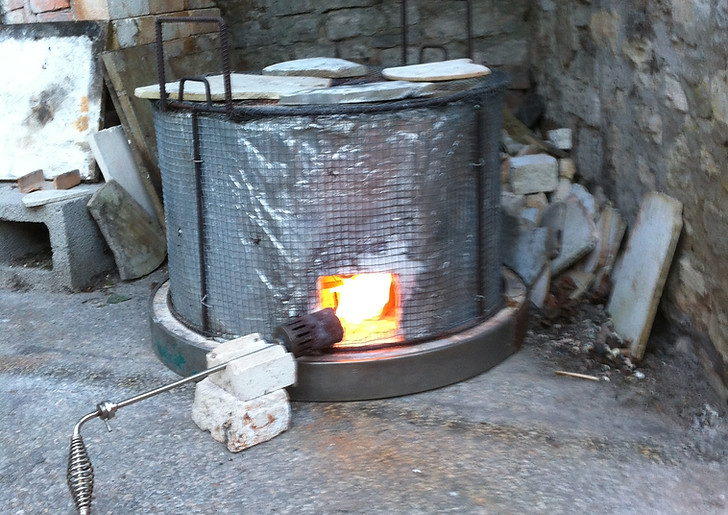What's RAKU?
Raku is an ancient Japanese rapid firing technique that was initially used to decorate ceramics used in traditional Japanese tea ceremonies. The western world has now adapted this technique to incorporate the addition of placing the red hot ware into combustibles creating reduction to create the distinctive crackle effect and sometimes beautiful flashes of copper in the finished piece.
Once cooled, a layer of black soot must be removed using wire wool. For me this is the most exciting part, as its when the soot is removed the beautiful Raku effects beneath are discovered.
No two pieces ever turn out the same!
Scroll down to see the Raku Firing process...
Bisque Fire
After hand building the individual pieces using stoneware clay.
I then 'Bisque' fire them in my electric kiln to 1000 degrees C.
This firing takes approximately 12 hours, and about the same to cool down.
I then glaze the pieces using specialist Raku glazes.

Raku Kiln
About 5-6 pieces are placed on kiln shelves inside the outdoor Raku kiln.
A gas torch is then used to rapidly fire the ceramic to 1000C.
This takes approximately one hour. Using the gas torch is a very noisy process!

Lifting Kiln Lid
Once the lid of the kiln is removed, the now glowing hot ceramics are then removed using black smiths tongs.
Fire retardant clothing and heat protective apron and welders gloves are required for this processes, along with a breathing mask, as the fumes are toxic.

Conbustables
The ceramics are now placed in a metal container containing various constables
that ignite on contact with the red hot ceramic.
Some artists like to experiment with various combustibles such as news paper, leaves and hay.
However in over ten years of Raku firing, I have found hard wood shavings to work the best.

Reduction
Closing the lid on the container rapidly reduces the oxygen within and creates a reduction process that causes the crackle effect within the ceramic and glaze.
The smoke from the combustibles then
enhances these crackles.

Taking the Plunge
After allowing the pieces to smoke and cool for approximately 20 minuets, I then remove them from the container using metal tongs and welders gloves. They are then cooled on wire racks for a further 30 minuets.
I then plunge each piece into water. This helps to set the effects.

Wire Wool Scrub
Each piece is now covered in a thick film of black soot.
This needs to be scrubbed off using wire brushes or wool to expose the Raku effects beneath.
This can be a tedious job, however it is also the most exciting, especially if the piece has crackled well.

The Finished Piece
The Raku effects are very unique, each firing is different so no two pieces are ever identical.
Any un-glazed parts are blackened by the smoke.
Sometimes flashes of copper can be seen along with beautiful blue,green and orange tones.
I still feel excitement and anticipation with every Raku firing and love to experiment with mixing my own Raku glaze colours.
